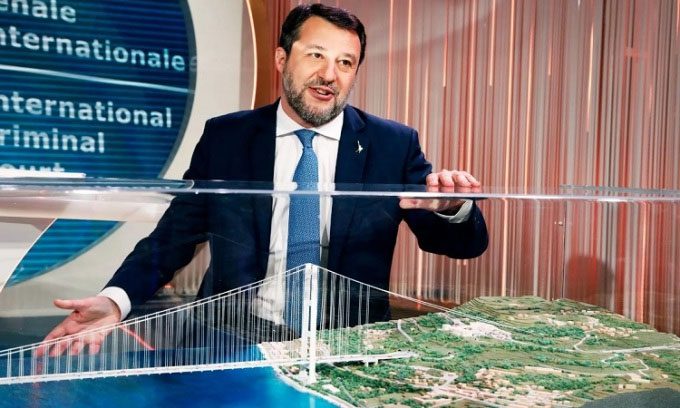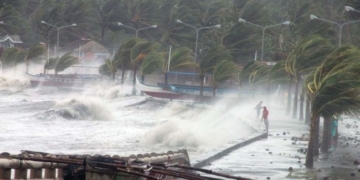After centuries, the idea of a 3,300-meter-long bridge across the Strait of Messina, connecting Sicily and mainland Italy, remains controversial and faces significant challenges to become a reality.
Following decades of political and technical debates, the Italian government is planning to construct the world’s longest suspension bridge, according to Wired. The first modern technical study of the bridge took place in 1866, where engineers concluded that the bridge was not feasible and proposed an underwater tunnel instead. However, the idea of building a tunnel was deemed too costly and complex, leading the government to initiate ferry services in 1896. The plan to build the bridge resurfaced as a topic of public discussion in the 1950s, with geological surveys being conducted. In 1969, the Italian government held an international competition to design the bridge, attracting 143 entries, including a winning design, yet none passed the preliminary design stage.

Italian Infrastructure Minister Matteo Salvini discusses the suspension bridge project. (Photo: Marco Ravagli)
It wasn’t until the 1990s that a single-span suspension bridge design was approved. The project became a political issue when Silvio Berlusconi used the bridge in his election campaign. Upon becoming Prime Minister of Italy in 2001, Berlusconi approved and funded the project. However, his leftist opponents canceled the project after he lost the 2006 election. Berlusconi was re-elected in 2008 and revived the project. Shortly after, the economic crisis led to Berlusconi’s resignation in 2011. His successor, Mario Monti, suspended the project for the last time in 2013.
In mid-March this year, the Italian government passed a decree paving the way for the bridge’s construction. The current design features a single-span suspension bridge measuring 3,300 meters, which is over 60% longer than the current record-holder, the Canakkale Bridge in Turkey (2,023 meters). With a tower height of 380 meters, the bridge over the Strait of Messina would also set the world record for the tallest bridge structure, surpassing the Millau Viaduct in France (342 meters). The bridge is designed to accommodate 6,000 road vehicles per hour and 200 ships daily. Since the bridge span will be 65 meters above water level, maritime traffic can occur beneath it without disruption.
The travel time by ferry between Sicily and mainland Italy currently takes about two hours; this will be reduced to under 10 minutes, bringing the nearly 5 million residents of Sicily closer to the mainland. According to Giuseppe Muscolino, a professor of engineering at the University of Messina, the initial plan included three spans with two bridge towers built offshore, each submerged 80 to 100 meters below sea level. However, that plan was deemed unfeasible due to strong tidal currents in the strait and risks to vessels.
“A single span has the advantage of having the bridge towers built on land. The only issue is the length of over 3 kilometers. The main obstacle is wind, but this design has been refined in a wind tunnel. I am confident that the bridge can be built safely,” Muscolino stated.
The construction process could take 6 to 10 years, according to Muscolino. However, Enzo Siviero, the engineer and bridge designer supporting the project, estimates that the timeline could be shortened to 5 years depending on funding. Siviero believes that much of the groundwork laid for the project before its suspension in 2013 could still be utilized. He also agrees that a single-span suspension bridge is the only viable option, with wind being the primary risk.
Due to the inherently flexible nature of suspension bridges, experts are less concerned about earthquakes, despite the area’s seismic activity. In 1908, a 7.1 magnitude earthquake nearly destroyed Messina and killed over 80,000 people. Nonetheless, according to Giovanni Barreca, a geologist at the University of Catania, the suspension bridge would be safe. “There is a fault line here that causes Sicily and Calabria to move apart by 3.5 mm per year, but the bridge has its towers on the same side. Therefore, from a technical and geological standpoint, the project remains feasible,” Barreca explained.
The biggest opposition to the bridge relates to environmental concerns. Environmental organizations have long opposed the project since the Strait of Messina lies between two protected areas that are crucial for the migration paths of seabirds and marine mammals. The economic factor is also contentious, as the estimated cost of $9.4 billion in 2011 is likely to increase due to rising material prices and inflation.
The bridge will need to be built between the two closest points in the strait, which is not where the ferries currently depart. This means additional roads will need to be constructed on both sides of the strait, potentially accounting for half of the project cost, according to Muscolino. However, the government plans for construction to begin in the summer of 2024.


















































